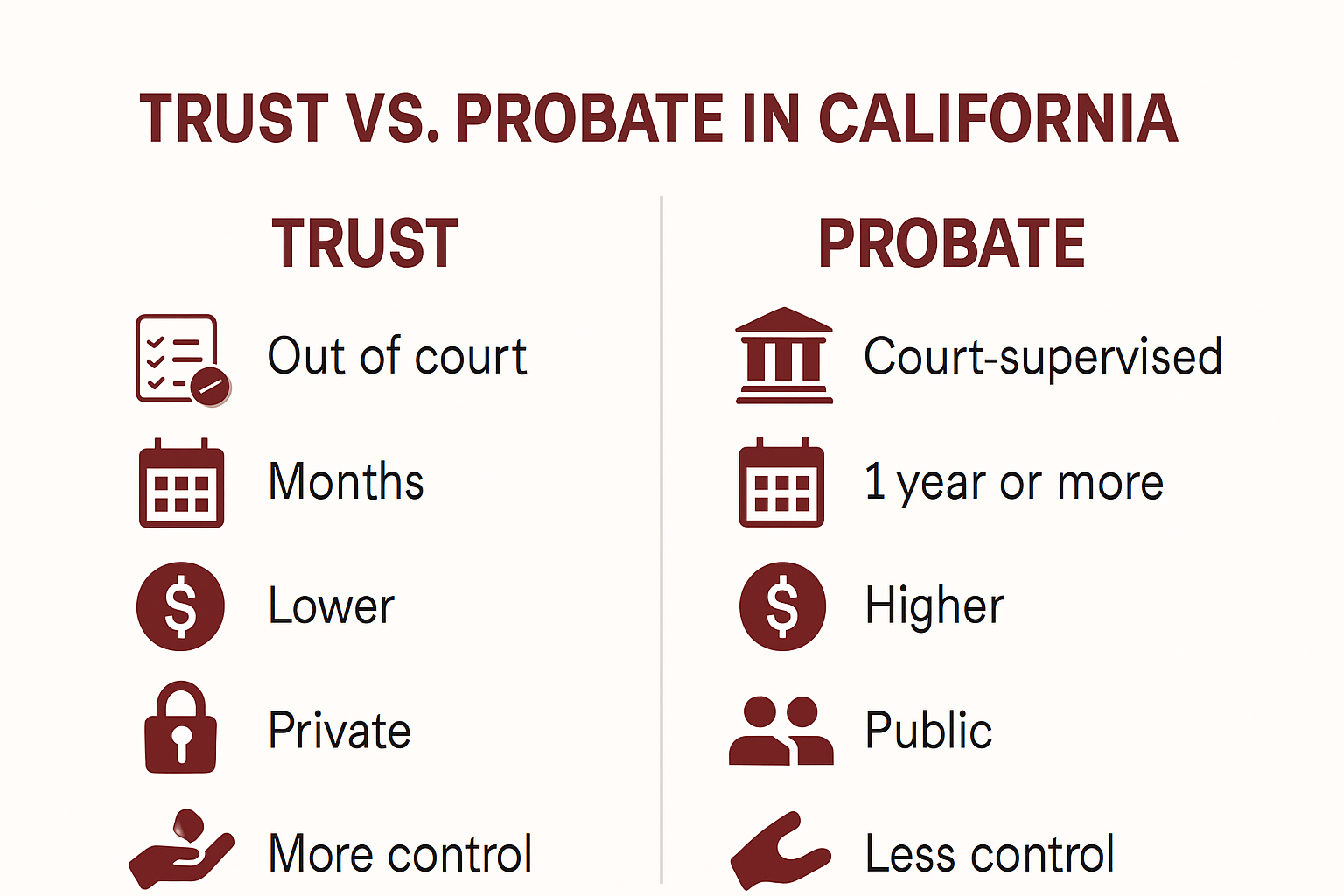
PARENTS & HOMEOWNERS: MY 7-STEP ESTATE PLANNING PROCESS WILL PROTECT YOUR HEIRS
From Creditors, Predators & Bad Choices, And Will Help You Become a (Bigger) Hero to Your Family!



Trust vs Probate Distribution in California: 2025 Guide
{
“@type”: “Article”,
“author”: {
“url”: “https://ridleylawoffices.com”,
“name”: “Ridley Law Offices”,
“@type”: “Organization”
},
“@context”: “https://schema.org”,
“headline”: “Trust vs Probate Distribution in California: 2025 Guide”,
“publisher”: {
“url”: “https://ridleylawoffices.com”,
“name”: “Ridley Law Offices”,
“@type”: “Organization”
},
“inLanguage”: “en”,
“articleBody”: “Learn the key differences of trust vs probate distribution for California families. Discover how the right plan protects wealth and secures your children’s future.”,
“description”: “Learn the key differences of trust vs probate distribution for California families. Discover how the right plan protects wealth and secures your children’s future.”,
“datePublished”: “2025-07-05T00:50:15.100Z”,
“mainEntityOfPage”: {
“@id”: “https://ridleylawoffices.com/trust-vs-probate-distribution-california-2025”,
“@type”: “WebPage”
}
}

California families often assume their assets will transfer smoothly after they pass. Here is where it gets surprising. Probate in California can swallow up 4 to 7 percent of an estate’s value and drag on for up to 18 months, slashing inheritances and draining family patience. Yet the real curveball is this. A simple change to using a trust can keep your wealth private, avoid court drama and ensure your family gets what you worked for faster than most people realize.
Table of Contents
- Understanding Trust Vs Probate Distribution
- The Probate Distribution Process
- Trust Distribution Advantages
- Key Differences In Asset Transfer
- How Each Option Affects California Families
- Financial Implications And Asset Protection
- Privacy And Family Dynamics
- Long-Term Planning And Flexibility
- Protecting Children And Wealth With The Right Plan
- Safeguarding Minor Children’s Inheritance
- Asset Protection Strategies
- Long-Term Financial Education And Guidance
- Common Pitfalls And Smart Solutions For 2025
- Overlooked Trust Funding Challenges
- Navigating Changing Tax Landscapes
- Legal Complexity And Adaptive Planning
Quick Summary
| Takeaway | Explanation |
|---|---|
| Probate is Time-Consuming and Expensive | The probate process in California can last between 9 to 18 months and incur administrative costs of 4% to 7% of the estate’s value, reducing beneficiaries’ inheritances significantly. |
| Trusts Offer Privacy and Flexibility | Trust distributions occur outside public court records, maintaining family privacy and allowing for conditional or staged distributions tailored to individual needs. |
| Importance of Proper Trust Funding | A trust must be properly funded—assets need to be transferred and titled to the trust—to be effective. Failing to do so can lead to unnecessary probate complications. |
| Adapting to Changing Tax Laws | Families need to be proactive about potential tax changes, particularly with the federal estate tax exemption decreasing after 2026, requiring strategic planning to preserve wealth. |
| Ongoing Estate Plan Review is Essential | Regularly reviewing and updating estate plans is important to account for significant life changes and to adapt to evolving California trust laws. |
Understanding Trust vs Probate Distribution
California residents face critical decisions when planning how their assets will be distributed after their death. Understanding the fundamental differences between trust and probate distribution can help families protect their wealth and minimize potential legal complications.

The Probate Distribution Process
Probate distribution is a court-supervised legal process that manages the transfer of a deceased person’s assets. When someone dies with a traditional will or without any estate planning, their estate must go through probate. In California, this process can be time-consuming and expensive. Research from the California Courts indicates that probate proceedings typically last between 9 to 18 months and can consume 4% to 7% of the estate’s total value in administrative and legal expenses.
During probate, a court-appointed executor inventories the deceased’s assets, pays outstanding debts and taxes, and ultimately distributes remaining assets to beneficiaries. This process is public, meaning anyone can access the details of the estate, which can create potential privacy concerns for families.
Trust Distribution Advantages
By contrast, trust distribution offers a more streamlined and private alternative. Our guide on estate planning strategies explains that a properly structured trust allows assets to bypass the probate process entirely. According to the California Attorney General’s office, assets held in a living trust can be transferred directly to beneficiaries without court intervention.
Trust distribution provides several significant benefits. First, it ensures faster asset transfer, often completing within weeks or months instead of the prolonged probate timeline. Second, trusts maintain family financial privacy, as trust administration occurs outside public court records. Third, trusts offer more flexibility in asset distribution, allowing individuals to create specific conditions or staged distributions for beneficiaries.
Key Differences in Asset Transfer
The primary distinction between trust and probate distribution lies in control and efficiency. Probate distribution is rigid, court-controlled, and potentially costly. Trust distribution empowers individuals to design personalized asset transfer strategies tailored to their family’s unique needs.
For California families with complex assets or specific inheritance wishes, a trust can provide unprecedented control. Whether protecting minor children’s inheritance, managing business assets, or creating conditional distributions, trusts offer a level of customization that traditional wills and probate cannot match.
Ultimately, understanding these distribution methods allows California residents to make informed estate planning decisions that protect their family’s financial future and minimize potential legal complications.
To help you quickly compare trust and probate distribution, see the table below summarizing their key differences:
| Feature | Probate Distribution | Trust Distribution |
|---|---|---|
| Timeline | 9–18 months (often longer) | Weeks to months (often much faster) |
| Cost (Administrative/Legal Fees) | 4%–7% of estate value | Typically much lower |
| Privacy | Public court records | Private, not part of public record |
| Flexibility in Asset Distribution | Rigid, set by court and state law | Highly flexible, set by trust terms |
| Asset Protection from Creditors | Limited; subject to claims | Can offer more protection (varies by trust) |
| Control Over Minor’s Inheritance | Limited, requires court involvement | Can include detailed age/milestone provisions |
| Custom Conditions or Staged Inheritance | Difficult/rare | Easily implemented in trust |
How Each Option Affects California Families
Estate planning decisions profoundly impact California families, with trust and probate distribution methods creating significantly different outcomes for inheritance, family dynamics, and financial security.
Financial Implications and Asset Protection
The choice between trust and probate distribution carries substantial financial consequences for California families. Research from the California Attorney General’s office reveals that probate can consume 4% to 7% of an estate’s total value in administrative costs, potentially reducing the inheritance beneficiaries receive. These expenses can quickly erode family wealth, especially for middle-class and upper-middle-class households with substantial assets.
Trusts offer a more strategic approach to asset protection. Our comprehensive guide to trust types explains how different trust structures can shield assets from potential creditors, legal challenges, and tax complications. For instance, irrevocable trusts can provide significant protection against future financial uncertainties, ensuring that family wealth remains intact for future generations.
Privacy and Family Dynamics
Probate proceedings are public records, which means anyone can access detailed information about a family’s assets, debts, and beneficiary designations. This lack of privacy can create tension and potential conflicts among family members. According to research from the California Courts, the transparent nature of probate can expose family financial details, potentially leading to disputes and emotional strain.
Trust distribution, conversely, maintains family privacy and allows for more nuanced asset management. Families can include specific conditions for inheritance, such as educational requirements or age-based distributions. This approach enables parents to create structured financial guidance for their children, protecting them from potential financial mismanagement.

Long-Term Planning and Flexibility
California families face unique challenges in estate planning, particularly when dealing with high-value assets like real estate and complex family structures. Insights from legal experts suggest that trusts provide unparalleled flexibility in addressing specific family needs. Whether managing assets for minor children, providing for family members with special needs, or creating multi-generational wealth preservation strategies, trusts offer customizable solutions that probate cannot match.
The ability to modify trust provisions allows families to adapt to changing circumstances such as marriages, divorces, births, or significant financial shifts. This dynamic approach ensures that estate plans remain relevant and effective, providing long-term financial security and peace of mind for California families.
Ultimately, the decision between trust and probate distribution is not just a legal choice but a deeply personal one that reflects a family’s values, goals, and vision for generational wealth preservation. Careful consideration of these factors can help California families make informed decisions that protect their financial legacy and support their loved ones’ future.
Protecting Children and Wealth with the Right Plan
California families face complex challenges when protecting their children’s financial future and preserving generational wealth. Strategic estate planning becomes crucial in ensuring comprehensive protection and responsible asset transfer.
Safeguarding Minor Children’s Inheritance
Parents must consider carefully how their assets will be managed if something unexpected occurs. Our comprehensive guide on protecting children’s future highlights the importance of structured inheritance mechanisms. According to California legal experts, trusts provide unique opportunities to create protective frameworks that prevent premature or irresponsible asset distribution.
A well-designed trust can establish specific conditions for inheritance, such as completing higher education, reaching certain age milestones, or demonstrating financial responsibility. These provisions ensure that children receive financial support in a controlled, strategic manner that promotes long-term financial stability.
Asset Protection Strategies
Beyond inheritance management, families need robust strategies to shield assets from potential future risks. Research from financial protection experts indicates that certain trust structures can provide significant protection against creditors, legal judgments, and potential financial disruptions.
Specifically, irrevocable trusts and spendthrift provisions can create powerful barriers against external financial threats. Our asset protection strategies demonstrate how these legal instruments can prevent creditors from accessing trust assets, protecting the family’s accumulated wealth from unexpected financial challenges.
Long-Term Financial Education and Guidance
Effective estate planning transcends mere asset transfer. It involves creating a comprehensive framework that educates and empowers future generations. Insights from family wealth management experts suggest that strategic trusts can incorporate provisions for financial education, mentorship, and gradual wealth introduction.
This approach allows parents to not just transfer assets, but to cultivate financial literacy and responsible wealth management skills. By implementing staged distributions tied to personal development milestones, families can ensure that inherited wealth becomes a tool for growth rather than a potential source of financial instability.
Ultimately, protecting children and wealth requires a holistic approach that combines legal sophistication, strategic planning, and a deep understanding of family dynamics. California families must recognize that effective estate planning is not a one-time event, but an ongoing process of adaptation, education, and thoughtful asset management.
Choosing between trust and probate distribution is more than a legal decision—it’s a profound statement about a family’s values, hopes, and commitment to supporting future generations. By carefully considering individual family circumstances and leveraging appropriate legal instruments, parents can create a robust financial legacy that nurtures and protects their children’s potential.
To better understand protective features trusts can offer for children and family wealth, here is a table summarizing key trust strategies discussed:
| Trust Strategy | Purpose/Benefit |
|---|---|
| Age/Milestone-Based Distributions | Releases assets to children upon reaching certain ages/milestones |
| Education Requirements | Ties inheritance distribution to completion of education |
| Financial Responsibility Clauses | Grants distributions if beneficiary demonstrates financial maturity |
| Spendthrift Provisions | Shields assets from creditors and prevents rapid depletion |
| Irrevocable Trust Structure | Provides robust protection from future lawsuits/claims |
| Financial Education Provisions | Encourages or funds financial literacy programs for beneficiaries |
| Staged/Gradual Wealth Introduction | Introduces assets in phases to foster responsible management |
Common Pitfalls and Smart Solutions for 2025
Navigating estate planning in California requires strategic foresight and understanding of potential challenges. As we approach 2025, families must be aware of emerging legal complexities and proactive solutions to protect their financial legacy.
Overlooked Trust Funding Challenges
One of the most critical mistakes families make is failing to properly fund their trust. Research from the California Attorney General’s office reveals that an unfunded or partially funded trust can render estate planning efforts ineffective. Simply creating a trust document is not enough. Families must meticulously transfer asset titles, update beneficiary designations, and ensure comprehensive asset integration.
For instance, real estate, bank accounts, investment portfolios, and personal property must be legally retitled to the trust. Our guide to avoiding estate planning mistakes emphasizes the importance of thorough asset transfer to prevent unexpected probate complications.
To help organize the trust funding process, here’s a simple checklist table of key trust funding steps mentioned:
| Step | Status/Reminder |
|---|---|
| Transfer real estate title to trust | Confirm deed change with county recorder |
| Move bank accounts under trust name | Visit bank to update account ownership |
| Assign investment portfolios to trust | Contact financial advisor for retitling |
| Update beneficiary designations | Ensure proper coordination with trust |
| Add personal property to trust | Prepare assignment of personal property |
| Verify all assets are integrated | Review trust asset schedule thoroughly |
Navigating Changing Tax Landscapes
The 2025 estate planning environment presents unique tax challenges. Federal tax law projections indicate significant changes in estate tax exemptions. Currently, the federal estate tax exemption stands at $13.9 million per individual, but this is set to decrease to approximately $6.5 million in 2026. This potential reduction demands proactive tax mitigation strategies.
Smart solutions include establishing irrevocable life insurance trusts, creating charitable remainder trusts, and implementing strategic gifting strategies. These approaches can help California families minimize potential tax liabilities and preserve more of their wealth for future generations.
Legal Complexity and Adaptive Planning
Estate planning is not a one-time event but an ongoing process. Legal experts recommend regular reviews of estate documents to account for life changes such as marriages, divorces, births, significant financial shifts, and evolving family dynamics.
California’s trust laws offer unique provisions that can benefit families. For example, recent legal changes now allow trustees to terminate trusts without court approval if the estate is worth less than $100,000, simplifying administration for smaller estates.
The most effective estate plans are flexible, comprehensive, and tailored to individual family circumstances. Families must consider not just asset transfer, but also potential scenarios like disability, long-term care needs, and protecting vulnerable family members.
As we move into 2025, the complexity of estate planning continues to grow. Technological changes, shifting economic landscapes, and evolving family structures demand a more nuanced approach to wealth preservation. By understanding potential pitfalls and implementing smart, adaptive solutions, California families can create robust estate plans that protect their legacy and provide peace of mind for generations to come.
Frequently Asked Questions
What is the difference between trust and probate distribution in California?
Trust distribution allows for faster, private asset transfer outside of court, while probate distribution is a court-supervised process that can be time-consuming and expensive, taking 9 to 18 months.
How much does probate cost in California?
Probate costs in California can range from 4% to 7% of the estate’s total value, significantly reducing the inheritance received by beneficiaries.
How can a trust protect my family’s privacy?
Trusts keep asset distribution private since they operate outside public court records, unlike probate, which is a public process where estate details can be accessed by anyone.
Why is it important to properly fund a trust?
Proper funding of a trust is crucial because unfunded trusts can lead to complications and may require going through probate, negating the benefits of having a trust in the first place.
Ready to Escape California Probate Hassles? The Solution is Simpler Than You Think
If you are worried about long probate delays, overwhelming legal fees, or losing family privacy as discussed in this article, there is a way to protect what matters to you. Many California families are shocked by how quickly probate can reduce their loved ones’ inheritances and create public family disputes. If your goal is to keep control and avoid court involvement, having a smart estate plan is crucial. We invite you to explore our Probate solutions page to understand your options and see why so many clients trust The Law Offices of Eric Ridley to secure their legacy.

Take the first simple step right now. Let us help you create a strategy that avoids probate headaches and keeps your family safe. Start your journey at https://ridleylawoffices.com or reach out for personal support. The peace of mind that comes from a clear estate plan is closer than you think.
Recommended
- Living Trust vs Will in California: 2025 Guide for Families – Law Office of Eric Ridley
- Real Estate in Probate: California Planning Guide for Wealthy Families 2025 – Law Office of Eric Ridley
- Probate Court Fees 2025: What California Families Must Know – Law Office of Eric Ridley
- Types of Trusts in California: Protecting Family Wealth in 2025 – Law Office of Eric Ridley
- Real Estate Probate Sales in California: How Families Secure Their Wealth (2025 Guide) – Law Office of Eric Ridley
- What Is Probate Litigation? A California Family Guide for 2025 – Law Office of Eric Ridley
